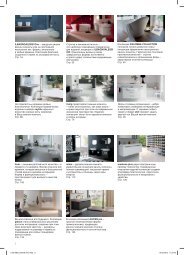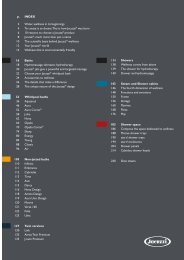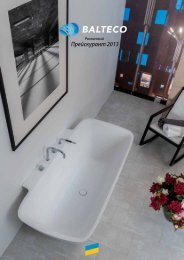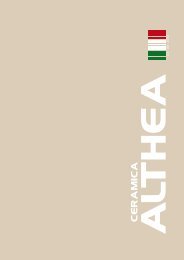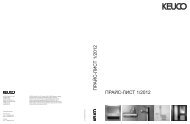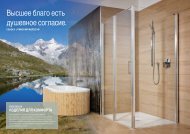Domus Linea
Create successful ePaper yourself
Turn your PDF publications into a flip-book with our unique Google optimized e-Paper software.
134<br />
CONSIGLI . KLINKER DOMUS<br />
Recommendations . Empfehlungen . Conseils . Consejos<br />
SCOLO DELL’ACQUA<br />
ALL’INTERNO DEL<br />
RIVESTIMENTO<br />
Non si dovrebbe nemmeno citare il fatto<br />
che i giunti strutturali e di deformazione<br />
necessari in base ai requisiti statici<br />
devono essere realizzati attraverso il<br />
rivestimento ceramico seguendo una<br />
certa "logica". E nello stesso modo<br />
devono essere concepiti, dal punto di<br />
vista costruttivo, i giunti di collegamento<br />
nell'edificio.<br />
I giunti di deformazione nel rivestimento<br />
stesso devono essere realizzati ogni<br />
2-4 m, in base alla configurazione della<br />
pianta dell'edificio. Anche in questo<br />
caso è meglio un giunto in più piuttosto<br />
che uno in meno. Occorre evitare<br />
qualsiasi tensione del rivestimento.<br />
1 Giunto di collegamento elastoplastico pendenza minima 2%. Elastoplastic control joint,<br />
mimimum slope 2%. Elastoplastische Verbindungsfuge mit einer Mindestneigung von 2%.<br />
Joint de raccordement élastoplastique inclinaison minimum 2%. Junta de unión elastoplástica<br />
pendencia mínima 2%.<br />
2 Terrazze interne su tetti – scolo dell'acqua attraverso grondaia conica a doppio isolamento<br />
termico. Internal roof terraces – water runoff via conical drain with double thermal insulation.<br />
Interne Dachterrassen – Wasserabfluss über eine konische Dachrinne mit doppelter<br />
Wärmeisolierung. Toits terrasses internes - écoulement d'eau par l'intermédiaire d'une<br />
gouttière conique à double isolation thermique. Terrazas internas su tejados – desagüe a través<br />
de alero cónico de doble aislamiento térmico.<br />
3 Piastrella Klinker o cotto. Klinker or terracotta tile. Klinker - oder Cottofliese. Carreau clinker ou<br />
terre cuite. Baldosa Klinker o Barro cocido.<br />
4 Adesivo di posa. Laying adhesive. Verlegungskleber. Collant de pose. Joint de raccordement.<br />
Adhesivo de colocación.<br />
5 Calcestruzzo protettivo. Protective concrete layer. Schutzbeton. Béton protecteur. Hormigón<br />
protectivo.<br />
WATER RUNOFF UNDER TILES<br />
There is no need to point out that a certain amount of logic must be used when fitting the structural and settlement joints needed to satisfy static<br />
requirements through the ceramic tiles. From the construction point of view, the connection joints inside the building must be fitted in the same<br />
way. The settlement joints in the ceramic top layer must be fitted every 2-4 m depending on the horizontal layout of the building. It is better to have<br />
one joint more than is needed rather than one joint less. The ceramic top layer must not be subject to stress.<br />
WASSERABFLUSS IN DER VERKLEIDUNG<br />
Ebenfalls braucht nicht erwähnt zu werden dass die unter Zugrundelegung statischer Berechnungen erforderlichen strukturellen Fugen und<br />
Bewegunsfugen durch die keramische Verkleidung unter Befolgung einer gewissen “Logik” herzustellen sind. Auf dieselbe Weise sind vom<br />
baulichen Gesichtspunkt aus betrachtet die Verbindungsfugen im Gebäude herzustellen. Die Bewegungsfugen in der Verkleidung selbst sind<br />
anhand des Grundrisses des Gebäudes in einem Abstand von jeweils 2-4 m einzuarbeiten. Auch in diesem Fall empfiehlt es sich, lieber eine Fuge<br />
mehr herzustellen als eine zu wenig. Spannungen in der Verkleidung sind unbedingt zu vermeiden.<br />
ECOULEMENT DE L’EAU Á L’INTÉRIEUR DU REVÊTEMENT<br />
Il est important de veiller à ce que les joints structurels et les joints de déformation nécessaires en fonction des standards statiques soient réalisés à<br />
travers le revêtement céramique en respectant une certaine logique. Les joints de raccordement de l'édifice doivent être réalisés au plan technique<br />
dans le respect de critères identiques. Les joints de déformation au niveau du revêtement doivent être réalisés tous les 2 à 4 mm en fonction du plan<br />
de l'édifice. Il est préférable que les joints soient en nombre excessif plutôt qu'insuffisant. Il est important d’éviter toute tension du revêtement.<br />
DESAGÜE EN EL INTERIOR DEL REVESTIMIENTO<br />
No se debería ni siquiera mencionar el hecho de que las juntas estructurales y de deformación necesarias en base a los requisitos estáticos deben<br />
realizarse a través del revestimiento cerámico siguiendo una cierta “lógica”. Y, de la misma manera, deben concebirse, desde el punto de vista<br />
constructivo, las juntas de unión en el edificio.<br />
Las juntas de deformación en el revestimiento mismo deben realizarse cada 2-4 m., en base a la configuración de la planta del edificio. En este caso<br />
también es mejor una junta más que una menos. Hay que evitar cualquier tensión en el revestimiento<br />
6 Armatura . Reinforcement . Bewehrung . Armature . Armadura.<br />
7 Strato divisorio. Separating layer. Trennschicht. Couche de séparation. Capa divisoria.<br />
8 Impermeabilizzazione. Proofing membrane. Abdichtung. Imperméabilisation.<br />
Impermeabilización.<br />
9 Doppio strato isolante. Double insulating layer. Doppelte Isolierschicht. Double couche<br />
isolante. Doble capa aislante.<br />
10 Barriera idrofuga. Moisture barrier. Wasserabweisende Sperrschicht. Barrière hydrofuge.<br />
Barrera hidrófuga.<br />
11 Vernice. Paint. Lack. Peinture. Pintura.<br />
12 Calcestruzzo in pendenza. Sloping concrete layer. Abfallende Betonschicht. Béton en déclivité.<br />
Hormigón en pendencia.<br />
13 Soletta di calcestruzzo. Concrete base slab. Betondecke. Chape en béton. Losa de hormigón.<br />
14 Intonaco. Plaster. Putz. Enduit. Revoque.<br />
15 Muratura. Concrete wall. Mauerwerk. Maçonnerie. Armadura.



